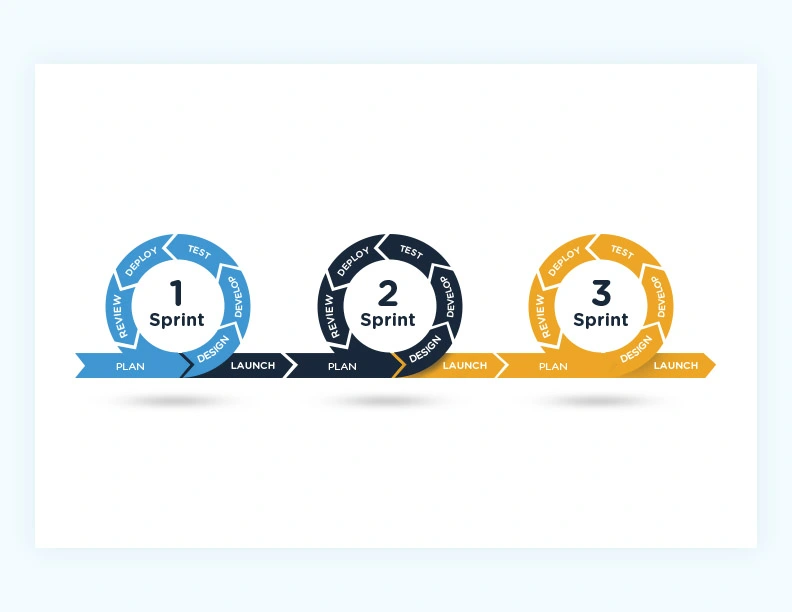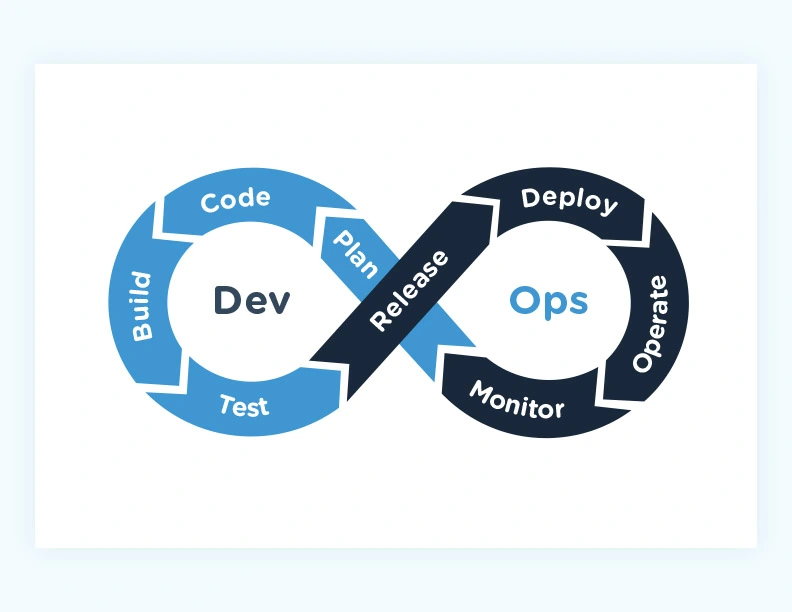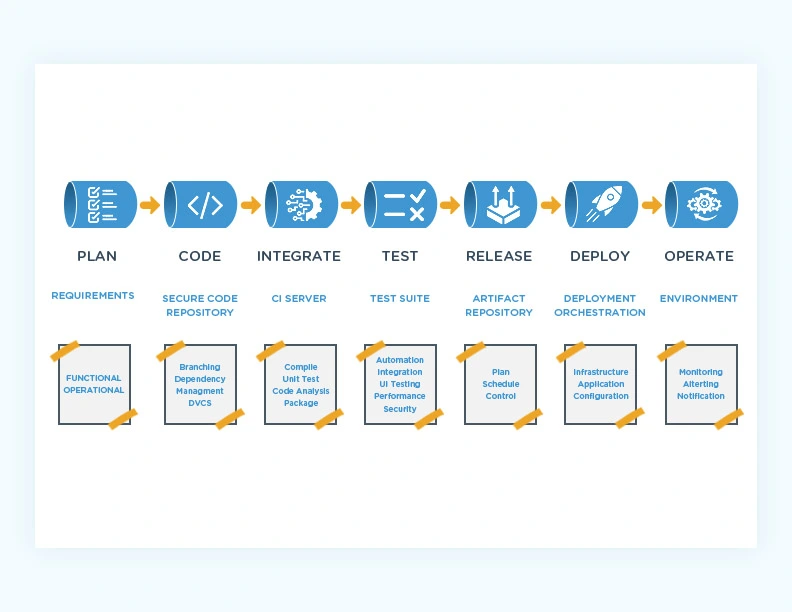DevOps and Agile are some of the most prominent concepts in modern IT. Agile emerged at the turn of the century to help development teams become more efficient than with previous approaches.
Several years later, around 2010, DevOps emerged as we know it today to enable development and operations teams to deliver better software products, more quickly, and together.
These two approaches have a lot in common, including inflated expectations. This tends to promote several misconceptions about Agile and DevOps.
In this guide, we’ll cover:
Table Of Contents
What Is Agile?
Agile is a framework for managing engineering projects that encourages collaboration, client feedback, and more frequent releases. Yet Agile is also a philosophy, a cultural shift away from the traditional Waterfall Methodology.

In Agile, project stakeholders come together for comprehensive planning before a project begins. After that, development takes place in small, continuous phases called Sprints. The Agile approach incorporates customer feedback into sprints as needed to make changes as the project progresses. That didn’t happen in Waterfall-based projects.
Agile is an umbrella approach, a collection of several different development methods, including Scrum, Kanban, and eXtreme Programming (XP).
But, while Agile has transformed how development (dev) teams collaborate, utilize automation, and deliver projects faster, it overlooked an essential component of successful software projects; operational efficiency in production environments.
DevOps was born to fill that gap.
What Is DevOps?
Like Agile, DevOps is a philosophy, approach, and cultural shift in software engineering organizations that emphasize collaboration, incorporating feedback more, and delivering high-quality software more rapidly.
However, DevOps incorporates best practices for not only development teams, but also operations teams — including deploying, monitoring, and optimizing the infrastructure where the completed software project runs.

In DevOps, representatives of the project’s customer, Dev team, Ops team, and management participate actively at every phase of the software development lifecycle.
An integral part of this lifecycle is implementing a continuous DevOps pipeline.

DevOps relies on this continuous collaboration and feedback loops to ensure that everyone is on the same page at all times.
DevOps enables teams to have a better understanding of how a product works. Thus, developers can advise on how to run it better, and operators can troubleshoot production problems faster.
Agile Vs. DevOps: What Is The Difference Between DevOps And Agile?
A major difference between Agile and DevOps is that while Agile focuses on the development phase of software projects, DevOps considers the entire software development lifecycle, including operations.
An agile project consists of small, self-contained teams working on small, self-contained tasks (sprints).
The DevOps model involves different teams working together to deliver quality code throughout the entire software development lifecycle, from design to production optimization.
So, which is better, DevOps or Agile?
The truth is that DevOps and Agile are complementary approaches. The two approaches are continuously iterative, collaborative, and encourage continuous releases. Agile guides development phases, whereas DevOps allows developers, operations, and leadership to collaborate to deliver quality software faster.
What Are The Most Common Misconceptions About Agile And DevOps?
There are a bunch of common misconceptions about DevOps and Agile. For instance, many people believe DevOps is a technology when in fact it is a set of processes and practices. Similarly, some believe that Agile is a linear process when it’s actually a set of flexible practices.
Here’s more.
1. That Agile and DevOps are methods of software development
Agile and DevOps are both overarching philosophies, not methods.
Both approaches require a paradigm shift, a cultural transformation from the inflexible, isolating, and linear approach of the Waterfall method to one that is more collaborative, feedback-informed, and iterative.
Methods like Scrum and Kanban are part of the Agile approach.
Meanwhile, DevOps can be implemented using a variety of methods, even Waterfall. The iterative and collaborative nature of Agile and DevOps is, however, a lot aligned, and they complement each other in different stages of an engineering project.
2. That DevOps and Agile are interchangeable
Despite their similarities, DevOps and Agile are not the same.
Through sprints, agile helps development teams deliver quality software more frequently.
An agile methodology is ideal for breaking complex projects into smaller, more manageable chunks, producing a minimum deliverable, obtaining feedback, and incorporating that feedback before or when moving on to the next phase.
DevOps allows developers, site reliability engineers, operations, and other teams in an organization to deliver quality outcomes in shorter, repeatable cycles.
The DevOps pipeline provides a methodology for implementing DevOps best practices. Agile emphasizes breaking complexity and improving efficiency, but DevOps emphasizes continuous improvement throughout a project’s lifecycle — long after it has been deployed.
Therefore, Agile and DevOps solve unique challenges for different teams and organizations.
3. That you can implement DevOps or Agile separately
Continuing from the previous point, Agile and DevOps are unique approaches. But they are not meant to replace each other. The two complement each other.
Instead, DevOps and Agile deliver the most benefits when implemented together. Yes, you can implement a DevOps culture through, say, a Waterfall methodology. But it would likely not be as aligned or seamless as deploying DevOps with Agile.
4. That Agile and DevOps can be purchased as tools off-the-shelf
This one’s huge. Because both approaches leverage a number of tools to achieve automation at different phases, it is tempting to believe that purchasing or subscribing to the best software development tools solves the Agile or DevOps challenge.
Instead, Agile and DevOps are about evolving your project management, software development lifecycle, and talent management at both the technical and non-technical levels. That is, through continuous everything:
- Continuous planning
- Continuous development
- Continuous integration (CI)
- Continuous deployment or delivery (CD)
- Continuous monitoring
- Continuous feedback
- Continuous improvement
In particular, DevOps and Agile approaches involve investigating, experimenting, and deploying the most efficient ways to build and deliver high-quality software more frequently.
For example, the two approaches encourage teams to build deliverables in smaller, continuous release cycles, upgrading and updating the software over time rather than developing it piecemeal.
5. That Agile and DevOps are only for large organizations
Both approaches were originally intended to help large organizations become more efficient. Yet, DevOps and Agile are suitable for smaller companies, too.
Introducing DevOps early in your company’s journey could prove immensely beneficial. Due to your leaner size and processes, for example, you can transition from your existing approach to full-on DevOps without much disruption. Plus, DevOps and Agile are iterative in nature, much like a growing organization evolving continuously.
In the same way, Agile and DevOps enable large organizations to become more responsive to market demand. This happens through continuously developing and delivering relevant products and services with minimal red tape.
6. That DevOps and Agile are specific ways of doing things
Here’s the thing. The DevOps approach is not a standard set of rules, but a collection of best practices to help your teams deliver quality software more quickly.
In other words, DevOps will look different in every organization because it should be tailored to your organization’s own needs — not necessarily how your peers implement it.
While agile is more prescriptive, it’s still an approach you can customize to fit the needs of your organization. Sprints will work differently for your organization than what others do because you have unique needs.
Yes, you can look at what others are doing, benchmark, and borrow what you think will improve your processes and outcomes. In general, though, DevOps and Agile approaches will look a lot like your unique objectives.
7. That DevOps and Agile will automatically improve costs
One of the major misconceptions about DevOps and Agile is that they generate IT savings either immediately or over time just because. This is inaccurate. In fact, depending on how you implement your framework, it could lead to higher costs than before.
Costs will increase initially, just like with any investment. However, as your teams, processes, and Cost of Goods Sold (COGS) become more efficient, these costs should decrease over time.
But it doesn’t just happen; there will always be something to spend more money on.
At CloudZero, what we recommend to our ambitious customers is to proactively monitor their DevOps costs, from cloud migration to everyday monitoring.
This is something you can do as well. You’ll need a robust cloud cost platform to track your DevOps implementation costs.
Cloud providers offer native cost tools, such as AWS’ Cost Explorer or Microsoft’s Azure Cost Management + Billing.
Yet, these tools only provide basic visibility, such as totals and averages, rather than the exact cost of supporting a specific customer, team, project, deployment, etc.
CloudZero Is Much More Effective
CloudZero’s cloud-native platform provides a comprehensive cloud cost intelligence solution that lets you focus on what matters most to you.
- CloudZero is cloud-native. From cloud migration to continuous monitoring, it seamlessly integrates with your DevOps and Agile practices at every phase.
- CloudZero delivers real-time cost observability. CloudZero gives you real-time cost anomaly alerts that detect cost spikes before they lead to overspending rather than waiting for the end of a billing cycle to determine what changes to make.
- CloudZero provides granular cost intelligence. Rather than showing you just totals and averages in a big cloud services bill, CloudZero breaks them down by customer, project, team, environment, service, and more dimensions.
- CloudZero delivers immediately actionable cloud cost insights. Once you know the specific people, processes, and products driving your cloud costs, you can take action more easily.
Based on a customer’s utilization, you can determine if you should revise their contract terms to protect your margins. Also, you can compare the costs of a specific feature with its revenue-generating ability. Then, you can decide if you can afford to provide it for free versus a paid option with a free trial period to make it profitable.
- CloudZero works even if you have messy cost allocation tags. Using a unique code-driven approach, CloudZero works more like an observability platform than a mere cost tool. By doing this, it can accurately collect and aggregate cost data from tagged, untagged, and untaggable resources, leaving no cost gaps.
- CloudZero also includes budgeting and forecasting, cost allocation (showbacks and chargebacks), and more in a single platform.
- Plus, you can use CloudZero Anycost to view your multi-cloud costs in one place; AWS, Azure, GCP, Snowflake, Databricks, New Relic, MongoDB, and more.
In fact, we recently used these very capabilities to find over $1.7 million in annualized savings for ourselves. Our customer, Drift, even saved $2.4 million in annual AWS spending using CloudZero.
You can save in the cloud too. Want to see how CloudZero can help?  !
!







